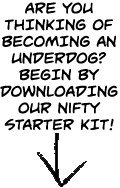The first one of these went well so let’s try another, shall we? Thanks to everyone who sent in questions (please continue to do so)! It’s looking like I’ll be answering one question a week so if you don’t see yours, keep checking back.
Today’s question is from Jennifer (Jenny?) P.
How many pages would you suggest I publish for my comic’s initial launch? It’s a webcomic (story driven). I plan to make buffers (20-30 pages) but not sure how many to upload on the initial launch.
















